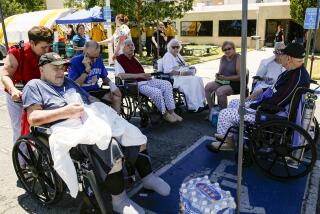Study of Cardiac Care Rates 2 Hospitals Low, 2 High
- Share via
Of 33 Orange County hospitals evaluated regarding their treatment of heart attack victims, two--Placentia Linda Community Hospital and Friendly Hills Regional Medical Center--scored “significantly worse than expected” in a state study to be released today.
Both Saddleback Memorial Medical Center and Columbia San Clemente Hospital and Medical Center, meanwhile, received the highest possible ratings.
Released by the state Office of Statewide Health Planning and Development, the “report card” is part of an effort to motivate hospitals in California to improve their services.
Of 398 California hospitals--about 90% of the total in the state--reviewed for the study, 17 were found to have performed “better than expected” and 22 “worse than expected.”
The study is to be used by health management organizations, insurance agencies and potential patients as a consumer’s guide to effective hospital service.
The state releases the report every two years--highlighting those that perform exceptionally well and those that are exceptionally poor in treating heart attack victims.
The ratings are based on information on deaths by heart attack occurring in California hospitals from August 1990 to June 1992, in comparison to the state average. Researchers began their work in July 1992, and the study has taken nearly four years to complete.
About 68,000 people suffered from a heart attack during that period and about 13% of those patients died, the state reported.
As expected, Orange County hospitals with high ratings exulted in the state’s praise while those with poor showings derided the accuracy of the report.
“It’s great to be recognized,” said Susan Littlefield, an administrator at Saddleback Memorial Medical Center in Laguna Hills. The hospital in 1991 employed a team of doctors, cardiologists and nurses to monitor the progress of all patients with heart problems, Littlefield said, which accounts for a high recovery rate.
Dr. Albert E. Barnett, chief executive officer of Friendly Hills Regional Medical Center in La Habra, said his hospital’s low rating “illustrates only the limited value of information the average consumer gets from these kinds of studies.”
Friendly Hills has an extensive cardiac program and sees more serious heart care cases than other hospitals, he said. Many terminally ill patients request that doctors not resuscitate them if they go into cardiac arrest, Barnett said.
“More than 30% of our mortalities fell into that category,” he said. “The study did not consider that as a factor.
“A lot of people don’t want to live on tubes and IV’s and all kinds of devices to be alive. We honor those requests.”
Margaret Thompson, director of patient care review services at Placentia Linda Community Hospital in Placentia, complained that the low ranking this year undermines changes that were made as a result of a poor showing in the state’s 1993 report of cardiac treatment facilities.
“We took that first study very seriously,” she said. “We made some significant changes after it came out.”
Despite improvements in such areas as education and length of time it takes to treat a patient in cardiac arrest, she said, the hospital is made to appear as if it is uncaring.
“It’s just not an accurate picture.”
Citing hospital policy, officials interviewed for this story declined to release information about the ratio of fatalities to total numbers of patients treated for heart attacks.
Lisa Simonson, who helped conduct the study, said “the concern should not be so great if a hospital receives a black mark for one year or even two. If you see a hospital with continual black marks, then you need to worry.
“This is not a flawless study,” she conceded. “It’s not completely accurate and there are many shortcomings that will be improved upon as the years go by.
“It’s really a just tool for asking additional questions,” Simonson said. “If a hospital has a low ranking, it shouldn’t be considered a final assessment.
“It should be a reason to approach them and ask, ‘What have you done about this?’ ”
More to Read
Sign up for Essential California
The most important California stories and recommendations in your inbox every morning.
You may occasionally receive promotional content from the Los Angeles Times.










